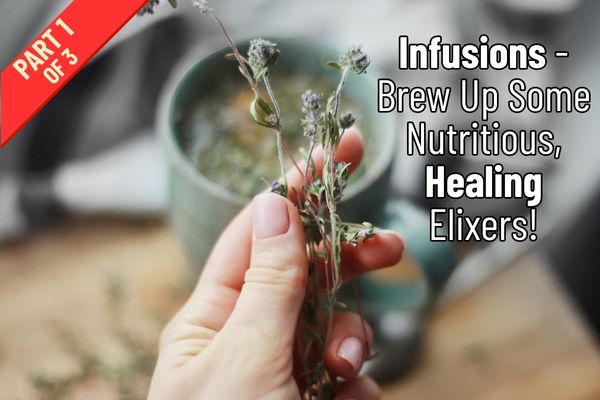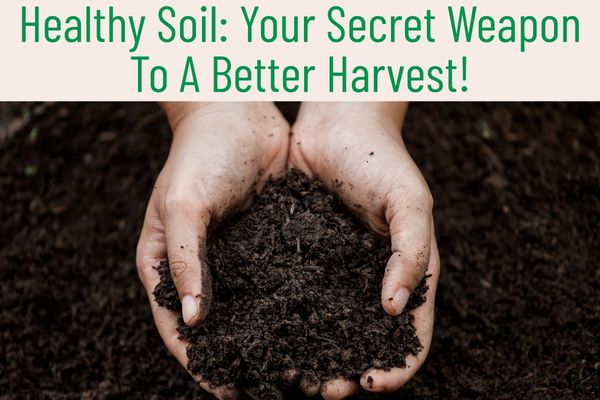When prepping for emergencies, you must think about the basics: food, water, shelter, security, and first aid.
Infusions can check off three boxes on that list: food, water, and first aid.
This simple and effective way to extract nutrients, flavors, and medicinal properties from plants requires minimal equipment, and can be made with foraged or stored herbs.
Get ready to discover what infusions are … why they matter for preppers … and how to make & use them for your health, well-being, and recovery.
What Is an Infusion?
An infusion is the process of steeping plant material (usually leaves, flowers, or soft stems) in hot or cold water to draw out their water-soluble components. If that sounds like tea, that’s because tea is one type of infusion. But in herbalism and survival medicine, infusions often involve longer steeping times and larger amounts of plant matter to maximize potency.
Infusions differ from decoctions, which are made by simmering tougher plant parts like roots, bark, and seeds. A future article will focus on that.
Why Infusions Matter for Preppers
For people preparing for disruptions, herbal infusions are useful because:
:: Minimal gear required. You only need a heat source, a vessel, water, and plant material.
:: Nutrient extraction. Many edible plants release vitamins and minerals into water when infused. Nettles, for example, are rich in calcium, iron, and magnesium.
:: Medicinal uses. Infusions support digestion, calm stress, ease sleep, soothe coughs, & provide light pain relief depending on the plant.
:: Hydration variety. In long-term emergencies, plain water gets boring. Herbal infusions, beyond their potential medicinal value, also add flavor.
:: Foraging compatibility. Many common wild plants make excellent infusions if you know how to identify them.
Gear Checklist
To prepare infusions efficiently, preppers should set aside a few basic items:
:: Heat source: camp stove, rocket stove, fire pit, or solar kettle.
:: Pot or kettle: stainless steel or enamel is best; avoid aluminum with acidic herbs.
:: Heat-safe jar or mug: mason jars work well for steeping and storage.
:: Strainer: a mesh strainer, cloth, or even a clean bandana can separate plant material from liquid.
:: Storage bottles: glass jars with lids or thermos bottles if you want to carry infusions.
:: Optional but useful: scale or measuring cups for consistency.
Step-by-Step: Making a Hot Infusion
The classic way to prepare an infusion uses hot water. Here’s the process:
Measure your herb.
:: For a medicinal-strength infusion: 1 ounce (about a loose handful) of dried herb per quart of water.
:: For a light beverage-strength infusion: 1–2 teaspoons dried herb per cup of water.
Boil water. Bring your water to a rolling boil.
Combine herb and water. Place your herbs in a jar or pot. Pour the hot water over them, filling the vessel. Cover tightly. Always cover while steeping to prevent volatile oils from evaporating.
Steep.
:: For beverage teas: 5–15 minutes.
:: For strong medicinal or nutritive infusions: 4–10 hours. Many people let them steep overnight.
Strain and drink. Pour through a strainer, squeezing or pressing the herbs to extract all liquid.
Storage. Refrigerate if possible. Infusions last 24–36 hours before they spoil.
Step-by-Step: Making a Cold Infusion
Cold infusions are better for delicate herbs that lose properties with heat, like marshmallow root (technically a mucilage-rich root often steeped cold but thought of in the infusion category).
<1> Place dried or fresh herbs in a jar.
<2> Cover with cool water.
<3> Cap and shake.
<4> Let sit 4–12 hours, shaking occasionally.
<5> Strain and use.
Cold infusions are soothing, less bitter, and excellent in hot climates where you don’t want to heat water.
Choosing Herbs for Infusions
For preparedness, focus on plants that are easy to store, forage, or grow. Below are some useful categories:
Nutritive Herbs
These provide vitamins and minerals. They are safe for regular use.
:: Nettle leaf: rich in iron, calcium, magnesium.
:: Oatstraw: good for nerves and mineral support.
:: Red clover: high in phytonutrients and mild flavor.
:: Alfalfa: nutrient-dense, though some people are sensitive.
Calming Herbs
For stress and sleep problems, common in survival scenarios:
:: Chamomile: gentle sedative and digestive aid.
:: Lemon balm: calming, antiviral, and tasty.
:: Passionflower: stronger calming effects.
Digestive Helpers
Helpful for when an irregular diet is unavoidable.
:: Peppermint: relieves gas, nausea, and stomach cramps.
:: Ginger (technically a decoction, but fresh slices can be infused): warming and anti-nausea.
Respiratory Support
Helpful in cough, colds, or smoky environments.
:: Thyme: antimicrobial, lung support.
:: Mullein leaf: soothes lungs and helps expectoration.
:: Hyssop: clears mucus.
Advanced Infusion Techniques for Maximum Potency
Beyond basic steeping methods, experienced preppers can employ specialized techniques to extract maximum therapeutic value from limited plant materials.
Solar Infusions
In sunny climates or during power outages, solar energy creates gentle, sustained heat perfect for delicate herbs. Fill a clear glass jar with herbs and water, then place in direct sunlight for 4-8 hours. The gradual warming extracts compounds without damaging heat-sensitive vitamins and volatile oils. This method works exceptionally well for flower infusions like chamomile or calendula, producing full-spectrum extractions while conserving fuel resources.
Sequential Extraction
Maximize plant material usage by preparing multiple rounds of infusions from the same herbs. After straining your first strong infusion, reuse the spent herbs for a second, lighter extraction. While weaker than the initial brew, this secondary infusion still contains valuable water-soluble compounds and extends your herb supply during shortages. This technique proves especially valuable with expensive or hard-to-find medicinal plants.
Combination Blending
Create synergistic effects by blending complementary herbs in single infusions. For example, combine nettle (nutritive), chamomile (calming), and peppermint (digestive) for a comprehensive wellness drink. Start with equal parts of each herb and adjust ratios based on taste and desired effects. Document successful combinations for future reference and consistent results.
Tips for Preppers Storing Herbs
:: Dried vs fresh: Dried herbs store longer and are easier to measure. Fresh herbs work but vary in strength.
:: Storage life: Most dried leaves and flowers last 1 year in airtight, dark containers. Roots and bark last longer.
:: Labeling: Always mark jars with name, part used, and date.
:: Sourcing: You can grow, forage, or buy in bulk from herb suppliers.
For long-term storage, store herbs in mylar bags with oxygen absorbers inside sealed buckets.
Safety Basics
Herbal medicine is generally safe when used with common sense, but beware the following:
:: Correct ID: Never use a wild plant unless you are 100% certain of its ID. Many plants look similar but are toxic.
:: Pregnancy and children: Some herbs are unsafe during pregnancy or for young children. Research before use.
:: Allergies: Start with small doses. People can react unexpectedly to herbs.
:: Drug interactions: Herbs interact with medications. For example, St. John’s wort reduces effectiveness of certain drugs.
:: Spoilage: Infusions spoil quickly. If it smells off or is fizzy, discard it.
Practical Uses for Infusions in Preparedness
:: Hydration alternative: Rotate between plain water and mild infusions to encourage drinking.
:: Nutrient backup: In scenarios where diet is poor, nettle or oatstraw infusion can replace missing minerals.
:: Sleep aid: Chamomile or lemon balm infusion can help you rest better even in stressful conditions.
:: Immune support: Elderflower infusion is a traditional remedy for fevers and colds.
:: Wound care: Strong infusions (cooled) can be used externally as washes or compresses. For example, yarrow infusion as a mild antiseptic.
:: Morale booster: Sharing a warm infusion around a fire builds community and comfort.
Infusions vs. Other Preparations
For preppers, it’s important to know when to choose an infusion versus another herbal preparation:
:: Infusions: Quick, water-based, best for immediate use.
:: Decoctions: Better for hard materials like roots/bark.
:: Tinctures: Alcohol-based extracts, lasts for years, very concentrated.
:: Capsules/powders: Convenient, but require advanced prep or storage.
Infusions are excellent for day-to-day use in an off-grid setting, while tinctures serve as long-term storage medicine.
Troubleshooting Common Problems
:: Too bitter: Steep for less time, or mix with mint or lemon balm.
:: Weak taste: Increase herb quantity or steep longer.
:: Cloudy or slimy infusion: This is normal with some herbs (like marshmallow). Strain well and refrigerate.
:: Spoiling fast: Always refrigerate if you can. If not, make smaller batches more often.
Building an Herbal Infusion Kit for Your Prep Supplies
Here’s a practical packing list for an herbal infusion kit:
:: Quart-size mason jars with lids.
:: Small camping pot or kettle.
::Reusable fine-mesh strainer or cloth.
:: A set of pre-measured dried herbs in mylar bags.
:: Labels and marker.
:: Optional: thermos for keeping infusion warm.
This compact kit ensures you can prepare infusions anywhere you can heat water.
Infusions – A Survival Tool In A Mug
For preppers, herbal infusions are more than just “tea.” They’re a survival skill, a health support system, and a morale booster all in one. With a small supply of dried herbs, a way to heat water, and basic knowledge, you can produce safe, nutritious, and therapeutic drinks on demand.
Infusions can’t replace modern medicine, but they can fill gaps when supplies are limited.
As you build your preparedness plans, add herbal infusions to your list of essential skills. Store some herbs, practice making infusions now, and learn to identify a few local plants that can be infused. In a crisis, that simple knowledge can help make you more resilient.




